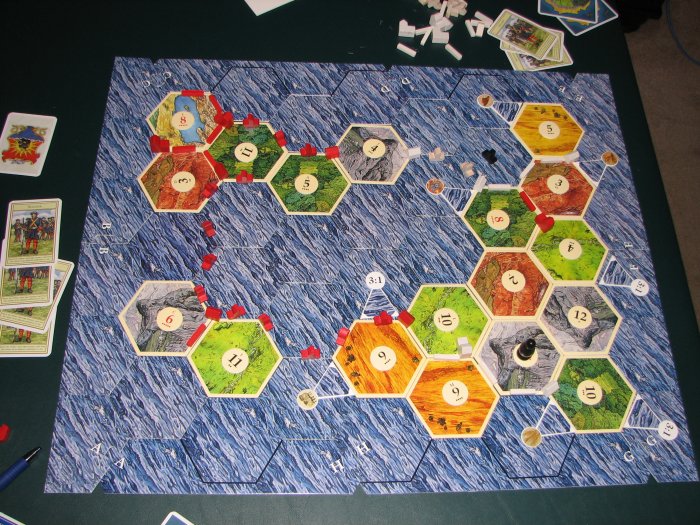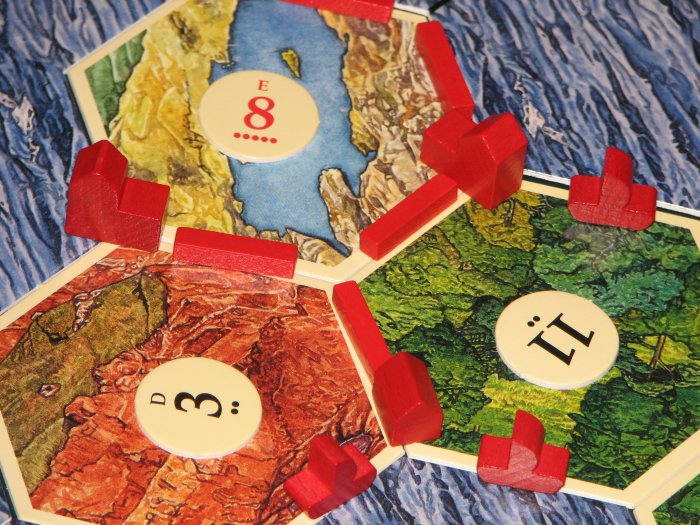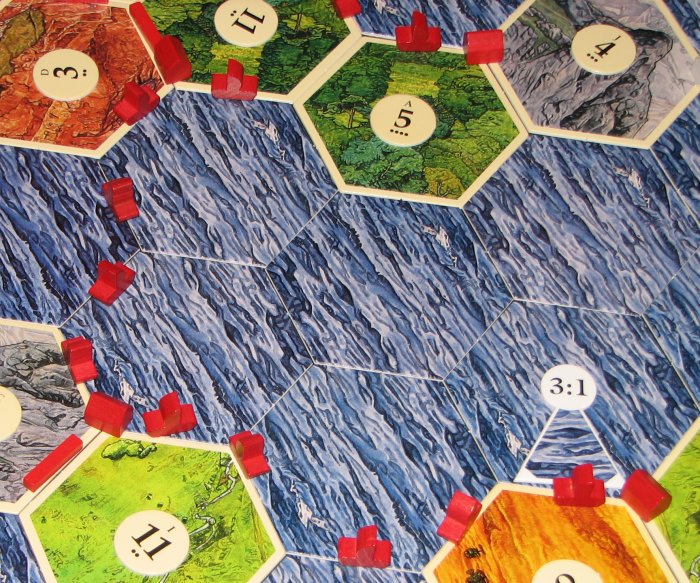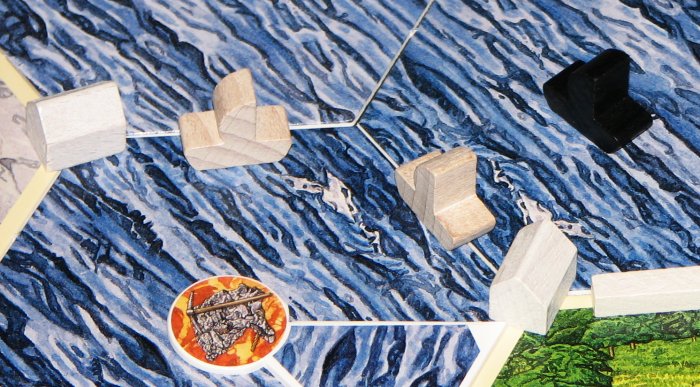So several weeks ago we bought the Seafarers of Catan expansion pack (for Settlers of Catan), but never really got around to playing it until this weekend. It’s not completely accurate to portray the delay as laziness or lack of interest, though… it was more of a desire to not screw up the game we loved so much. We really messed up Carcassonne with all the 40 bazillion expansion packs we added that complicate the game and increase its playtime to Monopoly levels, and I think we’re going to have to cull back some of those suckers and play in the virginal state for a while. But anyway, yeah, we didn’t want to ruin Settlers, but we bit the bullet over the weekend and just jumped right into it. And… oh my gootness… it’s an absolute blast.

The [absolutely yet unapologetically crappy] picture above is an endgame shot of scenario iv, which is one that has the players starting out on one island (the big one on the right) and working their way toward unexplored territory on the other end of the board. It’s interesting because there are actually 14 tiles missing on that left-hand side when you start the game, and they’re only revealed once you make your way to an empty spot by road or sealane. Note the addition of the connecting frames. They give the board a more “comfortable” shape, and this scenario would be quite impossible without it because you’d have no idea where that one funky looking landtile (present in the upper left-hand-corner at the start of the game) was supposed to go.

The above shows a better shot of the funky new terrain tile. It’s called a gold field, and basically you get any resource card of your choosing when it produces, kind of like an instant 1:1 trade relationship. Pretty sweet. You’ll notice the high-frequency pip and also the two cities sitting on it… those were mine, and of course I won this particular round. 🙂

The shot above shows the new traderoutes available via shipping lanes. Just look at my convoy of little red boats! Roads and sealanes can connect only at a settlement or city, but their lengths combine to figure the owner of the longest “road.”

Above you’ll see that poor Lynn had a pirate (the black ship) sitting next to one of her ships. Other than the booty I was able to take from her hand when I moved the guy there (hmm… I wonder now whose booty she was actually holding), this didn’t actually harm her. It basically keeps you from adding ships to or removing them from the affected tile, but she had already connected her little settlements by that time. Also notice the replacement for the harbor pieces. The one visible is the twofer on ore. They’re a nice addition, but I find them hard to see, especially given the increased size of the board (and the subsequent distance penalties afforded of same), and even harder to shuffle. If it’s not apparent, they’re like resource markers with triangles attached.
The setup was a little more complicated than that of the normal game, mostly because the placement of the harbors doesn’t make any sense whatsoever. We have to refer to the illustration in the booklet, which is sort of a downer, but we’re pros at randomizing the board and its pieces. Also frustrating will be actually separating these pieces from those of the regular Settlers set (the actual ownership of which Mayfair Games cleverly makes ABSOLUTELY necessary). I thought I would be smart and write an “S” on the backs of all the new land tiles, but 1) I later realized “S” could mean Settlers or Seafarers, and 2) you’d always know for sure that the next unknown tile would be a land one if there was an S on the back of the upside-down stack (I didn’t label waters because you can only use so many of them in the regular game anyway). So we resorted to dumping all the pieces in a sack and drawing them blind. Meh, that worked pretty well.
We also had to continue using our fudged rules since there were only the two of us instead of the requisite three or four (some scenarios require four, but I can see how this one would work quite nicely if one of our single friends dropped by):
- The victory point limit was raised to 14 rather than the 12 that this particular scenario called for.
- The safe limit for the number of cards in a player’s hand when the robber was played was raised from 7 to 9.
- Each player rolled twice per turn, but only a 7 on the first roll could activate the robber or pirate. A second 7 did nothing.
- A player rolling a 7 could always move the robber or pirate, but could only steal a card from his target if the number of victory points he actually had showing on the board was equal to or less than his opponent’s (hidden victory point cards excluded and not declared, of course!).
- A player using a purchased soldier card could always steal a card, regardless of how many victory points he had showing.
- No trading between the two players was allowed.
I can’t remember any other special rules off the top of my head, but I’m sure Lynn could correct me if called upon to do so. I think we’ll be playing this on a regular basis, and I’m really looking forward to trying it out with another couple!
And not to wantonly plant a seed, but I want to do that soon, if any of our couples-type-friends are reading this! 🙂